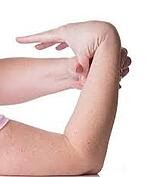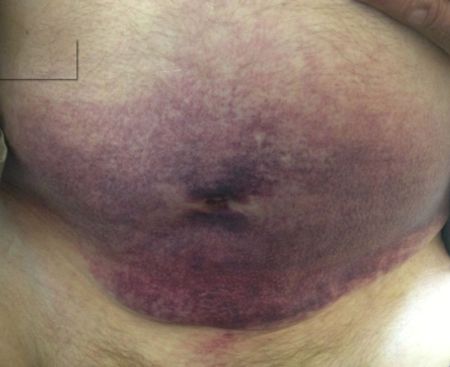

Also when my hands get mildly cold, the bruised finger suffers much worse than the others. Many drugs were tried for the treatment of the disease, without any significant improvement. The tip does not bruise and the finger, whilst bruised, is painful, difficult to bend and use. The syndrome results from complex somatic and psychological mechanisms. Abnormalities of the subcutaneous fat are similar to those of acute cellulitis, expressing the inflammation process secondary to the ecchymoses. The magnetic resonance imaging aspect of the lesions has never been described. The histology of early lesions reveals oedema of the dermis and modest perivascular infiltrate, whereas extravasated erythrocytes appear later. Haematological and immunological findings are usually normal. Fever, abdominal pain and external bleeding are possible. The lesions are characterized by recurrent, painful, swollen and bleeding bruises in any part of the body.

Painful bruising syndrome occurs most often in young women with various psychiatric problems. The ecchymotic lesions disappeared with adapted psychiatric treatment. Psychiatric evaluation revealed a severe personality disorder associated with depression. Because of the efficacy of saline serum injections on the symptoms and a pathological psychological profile, an autoerythrocyte sensitization syndrome was suspected. Antibiotics were inefficient on the pain and the aspect of the lesions. A cutaneous biopsy showed a moderate oedema of the dermis and erythrocyte extravasation. Magnetic resonance imaging showed normal muscles but modifications in the subcutaneous fat, similar to an acute cellulitis. The leg was red, warm, with diffuse bruising. Sometimes, when the inflammation is severe, an infectious cellulitis or muscular compression may be suspected.Ī 21-year-old woman was referred for the rapid occurrence of a diffuse and painful inflammation of the right leg, with fever. Australasian Journal of Dermatology Wiley Autoerythrocyte sensitization syndrome (painful bruising syndrome) is marked by spontaneous and painful ecchymotic bruising, without any biological abnormality, occurring in women with pathological mental profile. The main differential diagnosis in our case is that of recurrent erythema nodosum, but this is usually bilateral. The tender bruising in our case was localised to one limb and cannot be solely explained by autoerythrocyte sensitisation. Only the middle injection site developed a reaction. Stocker et aP informed their patients that only the middle injection represented their autologous blood and injected three adjacent sites with the same sample. However these positive results have been drawn into question by more recent studies implicating a factitial component. In some patients intradermal tests with whole blood, washed erythrocytes or their stroma has produced tender lesions which have been preceded by erythema suggesting an immunological response. Since the original description there has been continued debate whether the bruises are spontaneous or self inflicted and whether they differ from ordinary bruises by being associated with an immunological reaction to extravasated erythrocytes.

The clinical presentation of unexplained recurrent tender bruises occurring for twelve months in a young woman following local injury raises the diagnosis of the Gardner-Diamond Syndrome of autoerythrocyte sensitisation'^ This syndrome is seen precominantly in women and is often preceded by local injury or surgery in an individual under emotional stress. PAINFUL BRUISING SYNDROME PAINFUL BRUISING SYNDROME


 0 kommentar(er)
0 kommentar(er)
